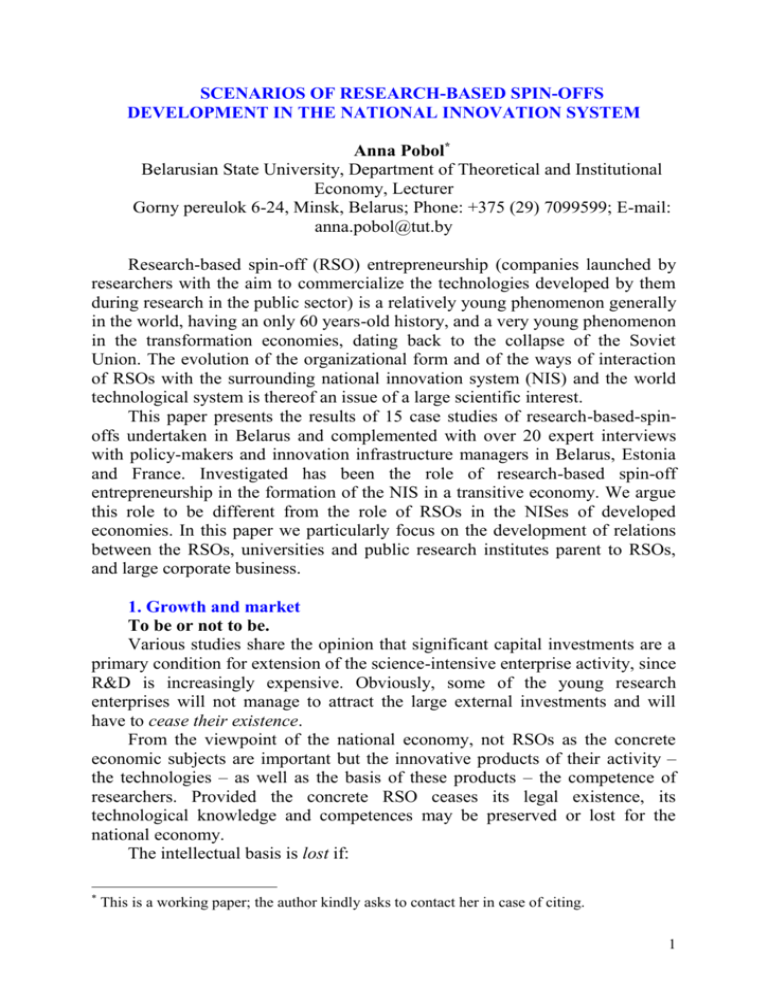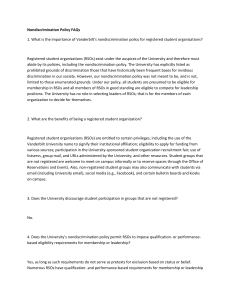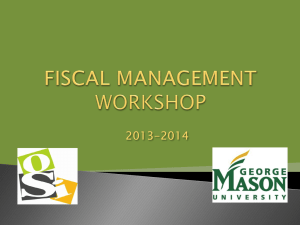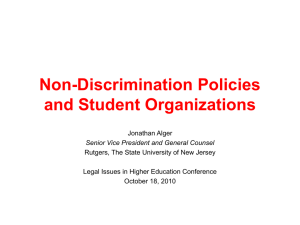3 - Russianlics
advertisement

SCENARIOS OF RESEARCH-BASED SPIN-OFFS DEVELOPMENT IN THE NATIONAL INNOVATION SYSTEM Anna Pobol* Belarusian State University, Department of Theoretical and Institutional Economy, Lecturer Gorny pereulok 6-24, Minsk, Belarus; Phone: +375 (29) 7099599; E-mail: anna.pobol@tut.by Research-based spin-off (RSO) entrepreneurship (companies launched by researchers with the aim to commercialize the technologies developed by them during research in the public sector) is a relatively young phenomenon generally in the world, having an only 60 years-old history, and a very young phenomenon in the transformation economies, dating back to the collapse of the Soviet Union. The evolution of the organizational form and of the ways of interaction of RSOs with the surrounding national innovation system (NIS) and the world technological system is thereof an issue of a large scientific interest. This paper presents the results of 15 case studies of research-based-spinoffs undertaken in Belarus and complemented with over 20 expert interviews with policy-makers and innovation infrastructure managers in Belarus, Estonia and France. Investigated has been the role of research-based spin-off entrepreneurship in the formation of the NIS in a transitive economy. We argue this role to be different from the role of RSOs in the NISes of developed economies. In this paper we particularly focus on the development of relations between the RSOs, universities and public research institutes parent to RSOs, and large corporate business. 1. Growth and market To be or not to be. Various studies share the opinion that significant capital investments are a primary condition for extension of the science-intensive enterprise activity, since R&D is increasingly expensive. Obviously, some of the young research enterprises will not manage to attract the large external investments and will have to cease their existence. From the viewpoint of the national economy, not RSOs as the concrete economic subjects are important but the innovative products of their activity – the technologies – as well as the basis of these products – the competence of researchers. Provided the concrete RSO ceases its legal existence, its technological knowledge and competences may be preserved or lost for the national economy. The intellectual basis is lost if: * This is a working paper; the author kindly asks to contact her in case of citing. 1 - researchers migrate to the other sector of economy, where their technological competence and R&D experience are not applied (e.g., trade); - researchers migrate to the other country, where their technological competences are applied and rewarded (or not applied but the labour is rewarded). Because RSOs are established by the intellectual elite of the country in the given technological field, this scenario means that the NIS can fully loose the capabilities to create innovations in this technological field. The intellectual basis can be preserved if: - researchers establish another company or start working fort he other domestic enterprise, applying their innovation experience and the technological competence; - researchers work as employees of the foreign enterprise’ R&D department in the territory of the domestic country. It is important to stress that not only is it necessary to preserve and continue to use the passive knowledge (e.g. via lecturing), but also the active knowledge of the innovators about the mechanisms of linking the technology to industry and introduction of it. To grow or not to grow. Successful scenarios of RSO development assume that the innovators manage to find the new ways of additional financing for their activity. Realistic here have proven to be the following scenarios: - transformation into a joint stock company or transfer of part of the stockes to the business-angel or venture capitalists who finances the growth of the company; - attraction of the foreign capital and transformation of the company into the joint or foreign company; - disappearance as an independent economic subject and transit into the ownership of the large innovation-oriented enterprise e.g. as an R&D department (the latter can be both a domestic enterprise or a multinational corporation). At home or abroad? Local versus international market. Important dimensions for the enterprise development is the geography of its market. Provided that the enterprise possesses a growth potential, a most strongly influencing factor which forms the geography of its market, is the factor of demand: availability of demand; its complexity, and its solvency. Because in the countries where the traditions of industrial and applied R&Ds are lacking (like Estonia in particular fields, or Kazahstan) also few are the advanced users of technologies, this may become a serious barrier for RSOs in enlargement of their local markets and survival in form of technologyintensive companies. On the other hand, this may serve as an incentive for them to internationalise their activity, provided that the necessary competencies are 2 there and the level of technological innovations of the company is able to meet competition. As Ove Granstrand (1998) notes, the successful scenario of the technologybased firms development is connected with their technological diversification, by means of which these firms become multinational. Also these companies have an incentive to economize on the increasing costs of the new technologies. To do this, they can follow the strategies of internationalization at the markets of both resources and products; technology related business diversification, marketing and search for the external technologies; R&D rationalization and technology related partnership, as Granstrand. Conversely, where the market is deep and capacious (as Russia for some Belarusian RSOs), the activity internationalization option is rather perceived by RSOs as a redundant risk; a favorable scenario for development of these firms will rather follow the path of “cultivating the newground” of the large domestic or neighbor market. Finally, the local market can also be a factor which geographically localises the efficiency of the company. Markets can be (geographically) specialized by complexity of innovation servicing and absorption capacity: beyond the definite markets some technological products might be non-reclaimed, resources might be inaccessible, and thus RSOs might be inefficient outside of these markets. 2. Cooperation Cooperation within the NIS. It has been found, that the schemes of RSOs relationships with parent universities and public research institutions vary between the countries, and especially at the early stage they influence significantly the success of technologies commercialisation process. Research-based spin-offs can generally emerge with, or without saving the link to parent organisation. In some countries it is this relationship which determines whether the new technology-based company will wear an official status of spin-off and hence will have definite rights and authorities, or be a “simple innovative company”. So, in Estonia, in order to receive a status of a spin-off, the company has to be registered in a national database and to sign a contract about the trademark with an authorized department of the university parent to spin-off. Additionally, if the research team of the RSO is gathered from different universities, the company can still be registered only as a spin-off of a single organization. Such approach, which we cannot consider a best practice, is led by the strivings of universities to regulate the intellectual property related payments from spin-off. Logically enough, there exist definite rules regulating the relations of the registered spin-offs with the parent university. For example, a scientists is receives a right to establish a company only in the case if his services are not competitive to the university activity. 3 We will consider the reasons why reseachers might prefer to preserve the tight linkages with the parent universities; to transform their relations into the ‘loose ties’ collaboration, the reasons for a scenario when the relations with a parent organization are quitted and for a scenario when the spin-off process does not happen. Main reasons for grounding the university spin-off and support of strong linkages with the parent organization. 1. Spatial closeness to university: colleagues, students, and infrastructure. 2. Easy possibility to rent squares or combine usage of infrastructure (inventory, machinery) for both academic and research aims, which is also not for free, but there exist special regulations for spin-offs and the transaction costs are as a rule lower. 3. In many countries the universities, more than other subjects of economy, possess international contacts. For small economies, where the volume of demand for a highly specialized or high-tech products is very limited, access to the international market is a very important asset. Here the trademark of parent university occurs to be very useful, as well as the inherited database and personal contacts. 4. One can have a common bookkeeping account, services on room cleaning and guarding, information and communication infratrsucture. 5. Good relationships with university management, “with director and the stab”. “Mainly researchers launch the spin-off company to feel supported, backed up”. One can generalize this scenario by the words of one respondent: “Success comes to the RSO only if the university wants this for the company”. After considering the main arguments used for reasoning why the university should hold control over the technologies commercialization, we will explore the objective and environment-caused reasons for a scenario why the innovative activity is organized under the framework of a parent organization and no spin-off process occurs; and why the RSO quits the relations with a parent organization. Networking. In spite of theoretically and empirically supported arguments for networking, there also exist important objective factors which prevent or restrict RSOs from networking. Cooperation beyond the NIS. Three schemes of RSOs’ intemediary role between domestic science, domestic industry and foreign technologies and foreign corporations are studied: subcontraction network; acquisition by a foreign company; learning by doing. We show which role these scenarios of RSOs development may play in overcoming of two main deficiencies of RSOs: resources contraints, and lack of managerial skills. 4 3. Evolutionary model of RSO development in the NIS In a last part of the paper, an evolutionary model is suggested, which shows the lifecycle of RSOs in a NIS in the conditions of the policy called by Clarysse, Heirman, and Degroof (2001) a “supportive” one. As research in the developed economies (where RSOs have managed to develop up to the state of the mature companies) show, there also exists a stage when the product of the RSO matures: the company “finds” some profile of the product which corresponds to the market needs, and stops the radical modifications of the product. However, simultaneously the requirements of the market in technological innovations develop with an accelerating speed, and the market will require either the new technology-based companies, or the reorientation of the old firms to the new technological products. From this strating assumptions the descriptive evolutionary model is developed. We refer to the fact that empirical works show that the profiles of RSOs development are non-homogenous (OECD, 2001) – and explain it by the not ideally “supportive” environment and by the NIS specifics. Selected literature Akhmetova, D. and G. Lekhnova (2005). The Role of International Co-operation in University Technology Transfer. The Case of The Ural State Technical University // New Technology-based Firms in the New Millennium / Eds.: W. During, R. Oakey, S. Kauser. – Elsevier Science Ltd., - P. 235-248. Audretsch, D.B. and E.E. Lehmann (2005). Do University policies make a difference // Research Policy. - Vol. 34. - P. 343-347. Autio, E. (1997). Early Growth and External Relations in New Technology-Based Firms. United States Association for Small Business and Entrepreneurship, - 19 p. Clarysse, B., Heirman, A. and J.-J. Degroof (2001). An institutional and resource-based explanation of growth patterns of research-based spin-offs in Europe // STI Review / Babson Center for Entrepreneurial Studies. - Vol. 26. – P. 75-96. Etzkowitz, H. (2004). The Evolution of the Entrepreneurial University // Int. J. Technology and Globalisation. –Vol. 1 (1). – P. 64-77. Grandstrand, O. (1998). Towards a Theory of the Technology-Based Firm // Research Policy. - Vol. 27. - P.465-489. Link, Albert N. and Siegel, Donald S. (2005). University-based technology initiatives: quantitative and qualitative evidence // Research Policy, Vol. 34: 253-257. Mustar, Philippe (2001). Spin-offs from Public Research: Trends and Outlook, STI // Science, Technology, Industry, Vol.26: 165-172. OECD (2001). Corporate and Research-Based Spin-offs: Drivers for Knowldege-Based Innovation and Entrepreneurship. Proceedings of the expert workshop held in Brussels, 18 January 2001. Castello, Tuebke, Miege, Yaquero (Eds.). - 149 Стр. Tether, Bruce S. (2002). Who co-operates for innovation, and why. An empirical analysis // Research Policy, Vol. 31: 947-967. University spin-outs in Europe – Overview and good practice. Directorate-General for Enterprise, European Communities, 2002. 5








